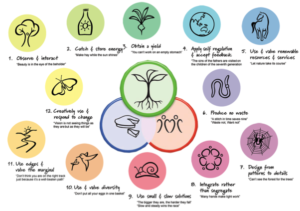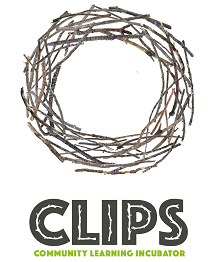Purpose and background
 Permaculture Design is a discipline that originated in Australia in the late 70’s, when Bill Mollison and David Holmgren’s book “Permaculture One” was published (1978). The term Permaculture comes from “permanent agriculture” (the design and creation of stable, long lasting and sustainable agricultural systems modelled from natural ecosystems) and permanent culture (the design of human habitats organically integrated in the natural ecosystems, which includes social aspects). Permaculture covers a wide field of knowledge and subjects, including ecological and regenerative design and engineering, integrated water resources management, environmental design and construction, agroforestry and sustainable farming, in general all the disciplines that relate to the creation of a sustainable human settlement, including economy and sociology. From observation of nature and its cycles, Mollison and Holmgren derive the design principles, for example, Observe and interact, Catch and Store Energy, Obtain a yield (Holmgren), and Every element has more than one function (Mollison). The lessons learnt by human civilization over the centuries are translated into Mollison’s Permaculture attitudes (the problem is the solution, work with nature and not against it, smallest change for the greatest effect, etc.). From observation of human history and culture, they identify the three Permaculture ethics: Earth Care, People Care, Fair Share. Other important elements in Permaculture design and strategy are: the Layers of trees and animals present in mature ecosystems; the Guilds, groups of animals and plants that naturally support each other, the Zoning system, from zone 0 to zone 5 (usually interpreted from the house to the wilderness); the Sectors (the impact of natural factors – like sunlight, wind, water, view – on the design); the Keyline design, a core strategy to keep water in the soil and increase its fertility and biodiversity.
Permaculture Design is a discipline that originated in Australia in the late 70’s, when Bill Mollison and David Holmgren’s book “Permaculture One” was published (1978). The term Permaculture comes from “permanent agriculture” (the design and creation of stable, long lasting and sustainable agricultural systems modelled from natural ecosystems) and permanent culture (the design of human habitats organically integrated in the natural ecosystems, which includes social aspects). Permaculture covers a wide field of knowledge and subjects, including ecological and regenerative design and engineering, integrated water resources management, environmental design and construction, agroforestry and sustainable farming, in general all the disciplines that relate to the creation of a sustainable human settlement, including economy and sociology. From observation of nature and its cycles, Mollison and Holmgren derive the design principles, for example, Observe and interact, Catch and Store Energy, Obtain a yield (Holmgren), and Every element has more than one function (Mollison). The lessons learnt by human civilization over the centuries are translated into Mollison’s Permaculture attitudes (the problem is the solution, work with nature and not against it, smallest change for the greatest effect, etc.). From observation of human history and culture, they identify the three Permaculture ethics: Earth Care, People Care, Fair Share. Other important elements in Permaculture design and strategy are: the Layers of trees and animals present in mature ecosystems; the Guilds, groups of animals and plants that naturally support each other, the Zoning system, from zone 0 to zone 5 (usually interpreted from the house to the wilderness); the Sectors (the impact of natural factors – like sunlight, wind, water, view – on the design); the Keyline design, a core strategy to keep water in the soil and increase its fertility and biodiversity.
CLIPS & Social Permaculture - Brief Example of the Process
In his book “Permaculture, Principles and Pathways Beyond Sustainability”(2002), Holmgren analyzed and explored 12 design principles, applying them both to natural ecosystems and to human habitats, and laid the foundation of our CLIPS & Social Permaculture Orientation Table and Assessment. Author and activist Looby MacNamara researched and expanded the field of social permaculture in her training and books (see bibliography below).
In CLIPS, we can apply Holmgren’s 12 principles (plus 2 additional design principles) to a community or a group, and identify areas of weakness where the principle is entirely – or partially – not applied. Since Permaculture is focused on the long-term storing of energy (in an ecosystem as well as a social system), this perspective gives us interesting information on where the group has an energetic deficit and what symptoms arise from this fault in its social design.
Outcomes / Benefits, Influence on the 4 layers of CLIPS:
The application of Social permaculture to the CLIPS model opens new perspectives and relates group processes to natural processes in the belief that “Nature is the Master”, a core value in the Ecovillage movement.
What is needed to put it in practice?
In the CLIPS programme, we have developed two complementary methods that relate the two approaches (both downloadable from this website):
– The Orientation Table that relate the principles to the four CLIPS layers, and identify the key indicators that highlight their effects on each layer; as several principles are closely related to each other, so are the effects on the group, and the table should be used with an organic approach to integrate the information we detect.
– The Assessment Tool supports the Clips Facilitator (who should be a Permaculture Design graduate) to identify areas of weakness or incoherence in the group. It puts in close connection specific situations, behaviors or patterns that recur in the group when a Permaculture Principle is not applied, not present, or insufficient; it helps the group identify possible symptoms that the CLIPS Facilitator will address to meet the group’s needs.
Further Information - Possibilities to get training in the approach.
Permaculture Design training is available in most countries and in most languages; a web search will give contact with the local Permaculture Academy, Association or Institute. Literature is also widely available in many languages, here is a short and very limited bibliography for the English reader, focused mainly on Social Permaculture aspects:
- Introduction to Permaculture, Bill Mollison and Reny Mia Slay (1994). Tagari Press
- Permaculture: A Designer’s Manual. Bill Mollison. (1988) Tagari Press
- Permaculture: Principles and Pathways Beyond Sustainability”. David Holmgren, Holmgren Design. Published in 2013 and revised in 2017
- People and Permaculture: caring and designing for ourselves, each other and the planet. Macnamara, Looby. (2012) Permanent Publications. (UK)
- Permaculture Magazine & Permanent Publications, https://www.permaculture.co.uk/
David Holmgren’s 12 principles

